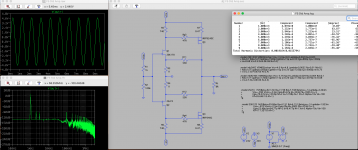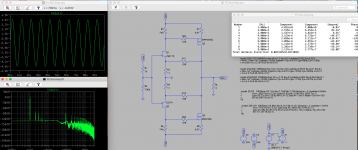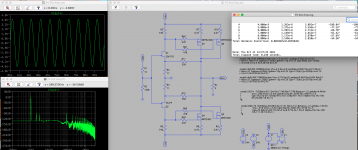Separate front end V rails?
I am sitting on 4 of cviller's F5 boards which have optional cascoding and dual output transistors, and when I put them together I will add P3 as well. But I got sidetracked with adding ps caps and biasing up an Adcom GFA-5200 to 20W of class A and an Adcom 5400 to 4W, and from these experiences now have one additional demand on my future F5:
I want the F5 front end running higher V rails than the output stage rails. On the '5200' the front end rails are +/-54V and output rails +/-42V, so 12V higher.
Are separate front end V rails possible to achieve on the F5?
Is 12V the right margin over the output rails to get full swing?
lhquam - A parallel output device (even just 2 pair) F5 with cascode front-end and P3, running at 35-40V rails would be an excellent higher-power, low-distortion amp. Basically a F5T “1.5” because no diodes.
I am sitting on 4 of cviller's F5 boards which have optional cascoding and dual output transistors, and when I put them together I will add P3 as well. But I got sidetracked with adding ps caps and biasing up an Adcom GFA-5200 to 20W of class A and an Adcom 5400 to 4W, and from these experiences now have one additional demand on my future F5:
I want the F5 front end running higher V rails than the output stage rails. On the '5200' the front end rails are +/-54V and output rails +/-42V, so 12V higher.
Are separate front end V rails possible to achieve on the F5?
Is 12V the right margin over the output rails to get full swing?
you can't do that, modulation path from FE to OS is referenced to rails...... so you must leave them intact
Btw I always found an F5 with the second pair of output to be a better sounding amp at all equal to a regular f5. Maybe a slight mismatch in the 4 outputs gives it some H2 and body, don’t know
I agree with that assessment.
And agree that I don’t know what the mechanism for the better sound is, but yes, parallel F5 sounds a bit sweeter than single pair.
And agree that I don’t know what the mechanism for the better sound is, but yes, parallel F5 sounds a bit sweeter than single pair.
Nelson killed the magic! Haha But why more body? F5 for me was always too clean and thin sounding amp even when it was (still is?) the lowest THD FW amp, doubling outputs fixed it…. But who am I to question the wizard though 🙂
Twice the open loop gain so twice the feedback and half the distortion?
I don't understand why adding a second pair of outputs would change the open loop gain of the amp. Can someone shine some light on this?
two mosfets in parallel are having twice xconductance
xconductance - amplification factor, current domain
Amperes on out per volt on input
xconductance - amplification factor, current domain
Amperes on out per volt on input
> two mosfets in parallel are having twice xconductance
ONLY if you also double the total bias.
Patrick
ONLY if you also double the total bias.
Patrick
Hm, when I double the outputs every pair has 1.25A so 2.5A total for the amp.
OLG gets about 6dB higher for doubled in Spice compared to standard. Is this a value to be expected?
OLG gets about 6dB higher for doubled in Spice compared to standard. Is this a value to be expected?
@EUVL
that was rough explanation
we know already from previous analysis how much, if Iq stays the same
though, worth mentioning, I didn't think of it
that was rough explanation
we know already from previous analysis how much, if Iq stays the same
though, worth mentioning, I didn't think of it
Hm, when I double the outputs every pair has 1.25A so 2.5A total for the amp.
OLG gets about 6dB higher for doubled in Spice compared to standard. Is this a value to be expected?
if you double Iq, xconductance is really twice previous (same being in function of Iq per device)
if you stay at same sum Iq, xconductance is decreased for each because Iq per each is decreased
how much - either measurements or calc from graphs readout
though, no ready available graphs for so low current range, except if someone published specific ones (no from manufacturers)
Yes, doubling the output devices allows twice as much output current. But output voltage stays the same. So voltage gain stays the same. At least that's how it works in my brain.
- Home
- Amplifiers
- Pass Labs
- Update on Pa's new F5?





